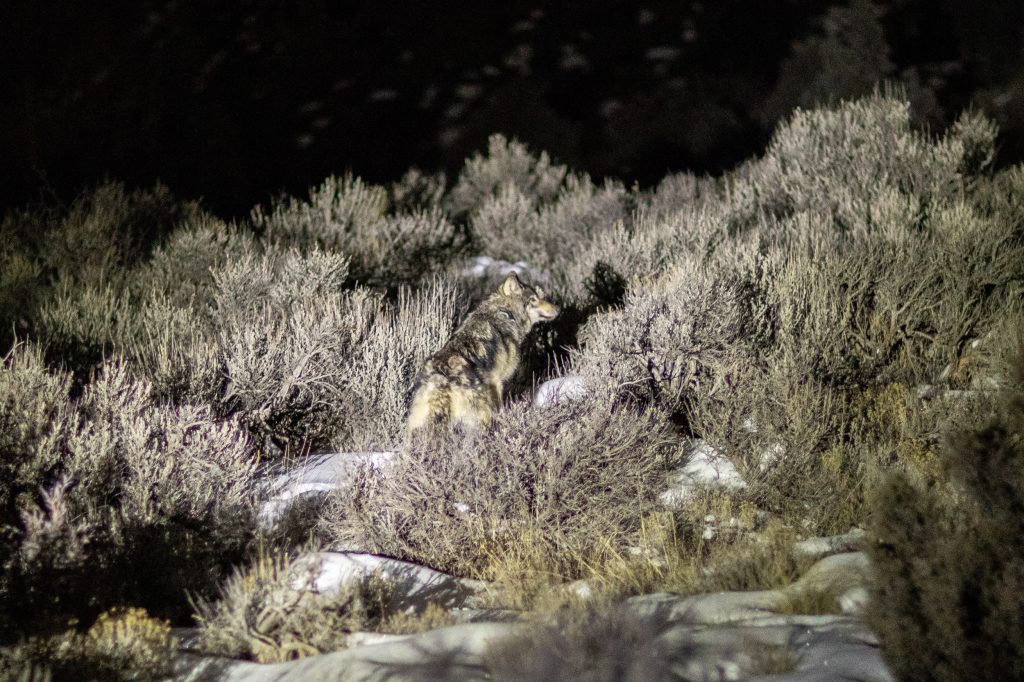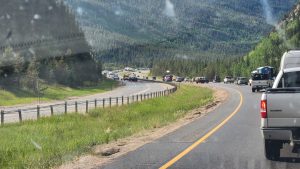Colorado Parks and Wildlife Commission approves over $130,000 to compensate ranchers for wolf-related losses, sparking debate over what is fair
Colorado Parks and Wildlife Commission approves over $130,000 to compensate ranchers for wolf-related losses, sparking debate over what is fair

Colorado Parks and Wildlife (CPW)
The Colorado Parks and Wildlife Commission at its Thursday meeting approved over $130,0000 to compensate two Western Slope ranchers for wolf-related livestock losses. The vote and hours-long debate emphasized a divide in the commission over what ranchers should be compensated for.
In the two claims before the commission on Thursday, while the ranchers and Parks and Wildlife officials agreed on some compensation elements, the crux of the disagreement stemmed from the statutory use of the word “missing.”
When voters passed the ballot measure in 2020 that required the reintroduction of wolves in Colorado, the proposition required that the state “pay fair compensation to owners of livestock for any losses of livestock caused by gray wolves.”
The state’s compensation program was created as part of the wolf management plan. The program allows ranchers to receive fair market value, up to $15,000, for the confirmed death or injury of livestock or guard/herding animals.
In addition to direct losses, the program allows producers with confirmed depredations to receive additional compensation for indirect losses such as missing livestock on large, open ranges and production losses. The latter of which can include decreased cattle and sheep weight gains and conception rates.
Both ranches with claims — Farrell Livestock, operating in Grand County, and Coberly Creek Ranch in Routt County — experienced significant losses from wolves in 2024, according to Kathleen Pritchard, an attorney representing both producers.
Parks and Wildlife was able to agree with both producers on the amount of compensation owed for the direct losses and for reduced weights and conception rates. However, Parks and Wildlife’s legal counsel recommended that the commission deny the amount requested for missing calves from both ranches.
For the Farrell property, the claim requested $100,045.57 for its missing cattle. It received $287,407.63 for the other losses claimed. For the Coberly Creek property, the claim totaled $30,860 for its missing cattle. The agency agreed to pay $66,807.29 for the ranch’s other losses.
In the form of a flowchart, ranchers have a few options for how they are compensated for missing animals and production losses.

One of these options — which both Farrell Livestock and Coberly Creek chose — is to receive payment for itemized losses, which has a higher bar of proof. This option requires producers to establish a “baseline” of livestock losses based on a three-year average before any wolf depredations occurred.
This helps account for what constitutes a normal amount of loss — that is, the livestock losses producers see from weather, disease and other predators — and whether there were significant increases in losses after a wolf depredation occurred on the ranch.
In the state statute guiding wolf compensation, the baseline pertains to all animals lost, a definition that includes animals that are missing and those that die.
“Claimants are eligible to receive compensation for missing animals only to the extent that the documented number of such missing animals claimed for the current year exceeds the claimant’s baseline death loss,” said David Cooperstein, an assistant attorney general with the Colorado Attorney General’s Office representing Parks and Wildlife on Thursday.
In recommending both claims for missing calves be denied, Cooperstein advised that “missing just means missing” and thus both ranches’ claims for missing livestock did not exceed the baseline loss enough to merit compensation.
Pritchard, however, argued that missing refers to animals both “missing and dead.”
“They are missing and that doesn’t matter why they’re missing,” she said. “It means they are just not there. So either they’re missing because they’re unaccounted for or they’re missing because they’re dead.”
Pritchard argued that the agency’s interpretation was “wrong” and “unlawful.”
“If the Farrells — who were the epicenter of last year’s depredations — don’t qualify for this compensation, it’s hard to imagine who would,” she said. “Farrell Livestock had 155 missing and dead calves last year, far more than the 92 missing and dead in the baseline years. That loss is hard enough. It shouldn’t be made worse by misreading the very regulation meant to help.”
About more than just one word
For some of the commissioners, the language of the statute and decision was clear. Commissioner Jay Tutchton called the agency’s legal argument a “slam dunk.”
Commissioner Jess Beaulieu said that it was “an unambiguous regulation.”
However, the commission was split, with the discussion touching on what constitutes “fair” compensation and what the ripple effects of a decision could be.
“Even though we’re struggling with some of this wording, the intent that I went into this was, number one, to make sure that the wolf reintroduction program was a success,” said Commissioner Dallas May. “Number two, I want to make sure that livestock producers, rural families, the people who are the stewards of our habitat and landscape, are not driven out of business.”
May spoke repeatedly about the importance of cooperation moving forward.
“We’re trying to compensate people fairly for losses, and we’re also trying to keep wolves on the landscape,” May said. “I think both of those things can be done and I think that’s the decision that’s in front of us.”
Tutchton said he found it difficult to blame all the losses accounted for on wolves.
While Jeff Davis, the director of Parks and Wildlife, said he would not speak to the “legalities” of the matter, he claimed to feel a “pit in my stomach” after hearing commissioners go back and forth.
“There’s a lot of grenade throwing … and I feel like people are losing hope,” Davis said. “When people lose hope, in my experience, they get desperate and desperate things start to happen.”
Davis acknowledged that the authority to make the decision fell to the commission, but that his job relies on “delivering stuff that keeps people at the table, or we all will lose in this deal.”
“Some really good people might walk away from the table when we need to keep them at the table and figure this out,” Davis added.
Ultimately, with the first Farrell Livestock claim, Tutchton moved to deny the claim as recommended by the agency’s counsel. This motion failed to pass with a vote of 6-5 — Commissioners May, Eden Vardy, Gabriel Otero, Frances Silva Blayney, Tai Jacober and Murphy Robsinson held the dissenting votes.
Then, rather than approve the claim, Robinson offered a motion to offer a settlement in the amount requested by the rancher in the claim. This passed by a vote of 9-2, with Commission Chair Richard Reading and Beaulieu dissenting.
The second claim for Coberly Creek’s losses saw the same two motions with commissioners voting along the same lines.
Colorado’s wolf compensation program is funded by the Wolf Depredation Compensation Fund, which legislators created in 2023. The fund receives annual allocations from the state’s general fund.
In the first year, 2023-24, the fund received a $175,000 transfer from the state general fund and is set to receive $350,000 in subsequent years. To date, the agency has received a total of $539,454 for the compensation fund. Should claims exceed the fund, the agency would be required to find another funding source to pay the claims.

Support Local Journalism

Support Local Journalism
As a Summit Daily News reader, you make our work possible.
Summit Daily is embarking on a multiyear project to digitize its archives going back to 1989 and make them available to the public in partnership with the Colorado Historic Newspapers Collection. The full project is expected to cost about $165,000. All donations made in 2023 will go directly toward this project.
Every contribution, no matter the size, will make a difference.










